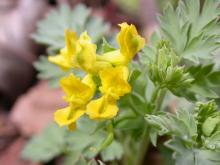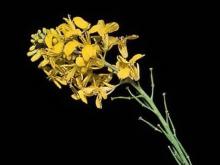Wildflowers, Grasses and Other Nonwoody Plants
Media

Species Types
Scientific Name
Phacelia purshii
Description
An annual, spring-blooming wildflower, Miami mist has loose coils of small blue flowers with distinctive, delicate fringes on the petal lobes.
Media

Species Types
Scientific Name
Alliaria petiolata
Description
Because each plant disperses a large number of seeds, garlic mustard can outcompete native vegetation for light, moisture, nutrients, soil, and space as it quickly colonizes an area.
Media

Species Types
Scientific Name
Corydalis flavula
Description
The smooth, finely divided, fernlike foliage of pale corydalis is similar to that of the related wildflower Dutchman’s breeches. But in pale corydalis, the small yellow flowers appear tubelike and lipped.
Media

Species Types
Scientific Name
Polygonatum biflorum
Description
Solomon's seal grows statewide in moist, rich earth. The greenish-white flowers dangle like little bells beneath the leaves, under the gracefully arching stems.
Media

Species Types
Scientific Name
Lespedeza virginica
Description
A bushy native perennial legume with small clusters of pink flowers, slender bush clover provides nectar for numerous insects. Several types of birds eat the seeds, and many mammals eat the foliage.
Media

Species Types
Scientific Name
Amsonia illustris
Description
Often found on gravelly Ozark streamsides, shining blue star lifts its clusters of showy, light-blue flowers in late spring. A top choice for native wildflower gardening, it is interesting spring, summer, and fall.
Media

Species Types
Scientific Name
Capsella bursa-pastoris
Description
Shepherd’s purse is a plant that started in Europe and western Asia and has been introduced nearly worldwide. Like the common dandelion, it has several adaptations that make it a successful colonizer of disturbed soil.
Media

Species Types
Scientific Name
Brassica nigra
Description
Next time you breeze past weedy black mustard on the highway or spot it in a fallow field, think of how important this and other mustards are to the world economy – and to your dinner table.
Media

Species Types
Scientific Name
Solanum carolinense
Description
Horse nettle is a native perennial with spiny stems and leaves, white to purplish flowers, and toxic fruits that look like tiny yellow tomatoes. It does well in disturbed habitats, and many people consider it a weed.
Media

Species Types
Scientific Name
Conyza canadensis (formerly Erigeron canadensis)
Description
Horseweed looks something like a goldenrod, except that the tiny composite flowers are not yellow. Instead, they are cream-colored and rather drab. In Missouri, this plant is especially associated with disturbed habitats and is a troublesome crop weed.
See Also
About Wildflowers, Grasses and Other Nonwoody Plants in Missouri
A very simple way of thinking about the green world is to divide the vascular plants into two groups: woody and nonwoody (or herbaceous). But this is an artificial division; many plant families include some species that are woody and some that are not. The diversity of nonwoody vascular plants is staggering! Think of all the ferns, grasses, sedges, lilies, peas, sunflowers, nightshades, milkweeds, mustards, mints, and mallows — weeds and wildflowers — and many more!





















